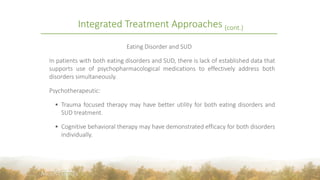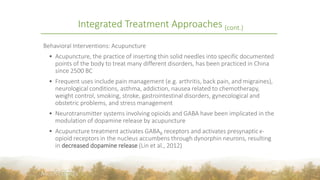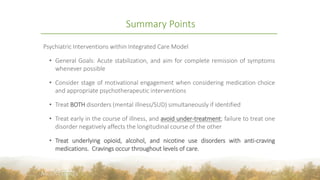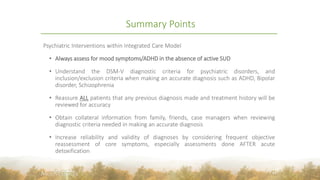The document discusses the integrated care model for treating substance use disorders (SUDs) in individuals with psychiatric illnesses, highlighting the prevalence of co-morbidities and the need for comprehensive treatment approaches. It outlines the history and definitions of dual diagnoses, the neurobiology of addiction and withdrawal, and various evidence-based treatment strategies, emphasizing the importance of individualized wellness plans. The integrated model promotes simultaneous treatment of mental health and substance abuse services to optimize recovery and address the complexities of co-occurring disorders.





![Substance Use Disorders in the Psychiatrically Ill (cont.)
Dual Diagnosis Epidemiology
In the Epidemiologic Catchment Area (ECA) Community Study sponsored by the
NIMH (Regier et al. 1990), lifetime prevalence of any SUD in a community sample
was 16.7%, whereas 29% of patients with lifetime history of mental illness met
criteria for lifetime comorbid SUD.
Of those with history of Drug Use Disorder’s (DUDs), more than half also had lifetime
history of mental disorder and had more than four times the risk (odds ratio [OR] =
4.5) of having a mental disorder compared with individuals with no history of DUD
(Regier et al. 1990)
Nicotine use disorder is prevalent in the US in 23% of general population (CDC and
Prevention 2002) but is 2-4X HIGHER in patients with mental illness and SUDs
(Kalman et al. 2005)
6](https://image.slidesharecdn.com/integrativecaremodeloftreatment-160719140926/85/Mountainside-Integrated-Care-Model-6-320.jpg)





































